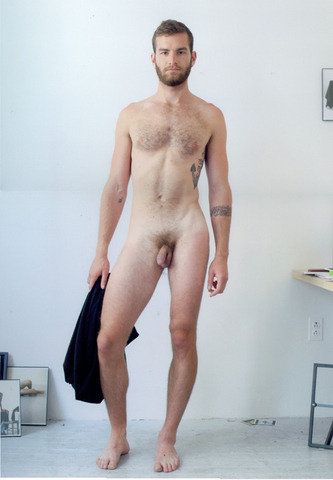Permanency
dal 13/8/2014 al 27/9/2014
Segnalato da
13/8/2014
Permanency
Leslie-Lohman Museum of Gay and Lesbian Art, New York
Selections from the Permanent Collection. The exhibition features selected works of art that have been accessioned by the Museum into its Permanent Collection. Approximately 70 objects will be on display, including photographs and collages, paintings, drawings, and prints from the mid-20th century to 2013.

[July 2014—New York, NY] Permanency features selected works of art that have been accessioned by the Museum into its Permanent Collection. Approximately 70 objects will be on display, including photographs and collages, paintings, drawings, and prints from the mid-20th century to 2013.
The Museum has more than 20,000 objects that it maintains in two separate collections – a Permanent Collection and a Study Collection – both stored and preserved in the same way, both devoted to honoring its rich artistic and cultural heritage. This exhibition will provide an opportunity to showcase some of those pieces that have been accessioned into the Permanent Collection of the Museum, which is currently comprised of approximately 1,300 pieces.
Highlights of this exhibition include:
• More than a dozen of the 30 works by Peter Hujar that were donated to the Museum by the Hujar Archive. The Museum is now the only institution that owns all three pieces in the Bruce de St. Croix series, which will be on display.
• Two photographs, Janet Heap and Margaret Anderson, by Berenice Abbott who moved to Paris in 1921 and apprenticed for Man Ray. She opened a studio in Paris and began making portraits of her community, the literary and artistic lesbians in her circle.
• Two boys aged 23 or 24, from: Fourteen Poems from C.P. Cavafy, by David Hockney, which was described as one of the most significant LGBTQ prints of the 20th Century. Completed in 1966, three years before Stonewall, its unabashed homoeroticism was unprecedented in the American art market.
• A work by Ray Johnson, a seminal Pop Art figure as well as an early conceptualist and pioneer of mail art. His innovativeness spread beyond the confines of the purely visual. Olive Oil and Mickey Mouse is a whimsical drawing by Johnson comprised of playful dialog with images.
• A sketchbook by Larry Stanton, who was a familiar sight in New York’s Greenwich Village in the 70s, provides a telling picture of faces from a segment of New York life that disappeared with the advent of AIDS.
Lesser known, however important artists will also be included such as Ingo Swann who, having worked for the United Nations for 10 years, left in 1968 to pursue his work as an artist and writer in his Bowery studio creating hundreds of paintings and collages. Swann received international fame for having co-founded remote viewing—a process in which viewers would view a location given nothing but its geographical coordinates—developed in part with funding from the CIA.
Curated by the Museum Staff, in addition to the artists above, Permanency will feature work by James Bidgood, Deborah Bright, Martin Burgoyne, Andy Burmeister, Wynn Chamberlian, Ronald Csuha, Leah DeVun, Dyke Action Machine (DAM), Charles Henri Ford, Nan Goldin, Red Grooms, Harmony Hammond, Clarity Haynes, Don Herron, Robert Indiana, Bill Jacobson, Alexander Kargalstev, Deborah Kass, Michael Kelly, George Platt Lynes, Christopher Makos, Josh McNey, Leah Michaelson, Duane Michals, Charles O’Neal, John Perreault, Ryan Pfluger, Paul Sepuya, Paul Solberg, Annie Sprinkle, Peter Stanglmayr, Arthur Tress, and Jessica Yatrofsky.
During the run of the exhibition, the Museum will be offer a number of public programming, events including a talk with director, designer, and educator, Robert Wilson on August 17 from 6 to 8 pm. During that presentation, Wilson will be in conversation with curator Jonathan D. Katz about poignant moments of Wilson’s career, the relationship between sexuality and creativity, and the Watermill Center—a unique environment for young and emerging artists from around the world to explore new ideas.
About the Leslie-Lohman Museum of Gay and Lesbian Art
“...invaluable museum.” Holland Cotter, New York Times, June 2013
Best place for gay culture, Time Out New York: New York's Best 2012
The Leslie-Lohman Museum of Gay and Lesbian Art is the first and only dedicated gay and lesbian art museum in the world with a mission to exhibit and preserve gay and lesbian art, and foster the artists who create it. The Museum has a permanent collection of over 22,000 objects, 6-8 major exhibitions annually, artist talks, film screenings, readings, THE ARCHIVE - a quarterly art newsletter, a membership program, and a research library. The Leslie-Lohman Museum is operated by the Leslie/Lohman Gay Art Foundation, Inc., a non-profit founded in 1987 by Charles W. Leslie and Fritz Lohman, who have supported gay and lesbian artists for over 30 years. The Leslie-Lohman Museum embraces the rich creative history of the gay and lesbian art community by informing, inspiring, entertaining, and challenging all who enter its doors.
Image: Paul Sepuya, Ryan, May 26, 2011, C-print, 19.938 x 15.063 in. Gift of the Christian Keesee Collection.
Contact: Jerry Kajpust
Deputy Director for External Relations
Jerry@LeslieLohman.org
212-431-2609
An opening reception will be held on Thursday, August 14 from 6 to 8 pm.
Leslie-Lohman Museum of Gay and Lesbian Art
26 Wooster Street in the SoHo neighborhood of New York City
Tuesday through Sunday, 12-6 pm, and Thursday, 12-8 pm.
The Museum is closed Monday and all major holidays
Admission is free



